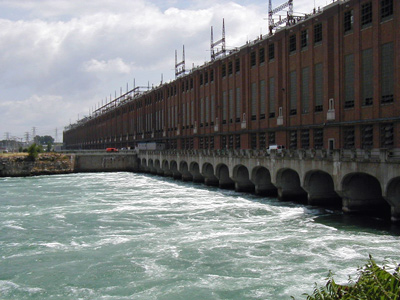Beauharnois Power Development National Historic Site of Canada
Beauharnois, Quebec

General view
(© Parks Canada | Parcs Canada, 2002.)
Address :
80 de Melocheville Boulevard, Beauharnois, Quebec
Recognition Statute:
Historic Sites and Monuments Act (R.S.C., 1985, c. H-4)
Designation Date:
1990-11-16
Dates:
-
1929 to 1932
(Construction)
Other Name(s):
-
Beauharnois Power Development
(Designation Name)
Research Report Number:
1969-031, 1986-SUA, 1986-OB-08, 1990-045, 2012-CED-SDC-018
Plaque(s)
Approved Inscription:
In 1929, the Beauharnois Light, Heat and Power Company began building the Beauharnois power plant and canal. The abundant power generated by plants like this one transformed both the industry and the lives of everyday Canadians in the first decades of the 20th century. An associated political and financial scandal provoked opposition to electricity trusts and contributed to the first phase of electricity nationalization in Quebec in 1944. Canal expansions between 1948 and 1961 made Beauharnois a key component of the St. Lawrence Seaway and created the largest power plant in Canada at that time.
Description of Historic Place
Beauharnois Power Development National Historic Site of Canada is a dam on the St. Lawrence River that spans the northern entrance to the Canal de Beauharnois. The town of Melocheville is located on the western canal bank and the town of Beauharnois on the eastern bank. Situated on both banks and across the canal, this imposing Art Deco structure contains 38 generating units set in a structure that stretches 900 metres. Concrete arches span the water to support 40 monumental brick bays featuring triple windows and an exterior walkway. Constructed in 1929, the power plant is served by a 26-kilometre-long power and navigation canal that provides water to drive the turbines. Official recognition refers to the building, engineering components and related structures on the legal lot at the time of designation.
Heritage Value
The Beauharnois Power Development was designated a National Historic Site of Canada in 1990. It is recognized because:
along with other early hydroelectric developments, its cheap and abundant electric power transformed both industry and the lives of Canadians; it symbolises, in many ways, Quebec’s entry into the technological age; huge in scale, the financing of the project was promoted by private interests and supported by public figures in government, which led to questionable practices and set off a scandal, the outcome of which upheld the rights of private enterprise; on completion, it was one of the largest hydroelectric power developments in the world and in the early 1960s, Canada’s biggest single installation.
Beauharnois Power Development was designated a national historic site because it symbolizes Québec’s entry into the technological era. Although the development did not display new technology, it was a massive project for its time and continued to have a central role in the production of hydroelectric power nation-wide. It is also associated with the power struggles for its financing and control. This large project helmed by the Beauharnois Light, Heat and Power Company proved difficult with rival interests, political opposition, questionable practices and adverse publicity which brought the project to the public’s attention. The state, as arbiter, played a key role in saving the project from bankruptcy and helped to turn it into to a more stable financial enterprise. The finished power plant went online in 1932 but did not achieve its intended size, due in part to reduced energy demands caused by the 1930s economic depression. In 1944 the Commission hydroélectrique de Québec (or Hydro-Québec) was created and the Beauharnois Power Corporation passed to the public sector. Demand for electrical power grew during and after the war, the powerhouse was extended and, for a time subsequent to 1961, the Beauharnois power development was the largest in Canada.
Source: Historic Sites and Monuments Board of Canada, Minutes, November 1990; Status of Designation Committee, Minutes, March 2012.
Character-Defining Elements
Key elements contributing to the heritage value of this site include: the prominent location spanning the water and on the both banks of the canal; the setting at the head of the Beauharnois Canal between the towns of Melocheville and Beauharnois; the long, monumental, flat-roofed massing; the concrete construction clad in brick; the structure’s classical Art Deco style and the façades that face the canal waters includes a lower, outer walkway, the repeating lower concrete arches, and the regularly placed windows in sets of three that illuminate the interior; the interior configuration, features and finishes, including the generating units; the principal engineering components of the installation that include the submerged components; viewscapes north along the across the St. Lawrence River and south along the Beauharnois Canal.